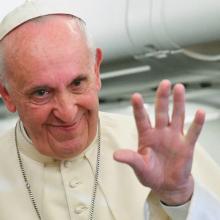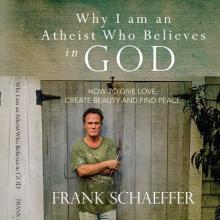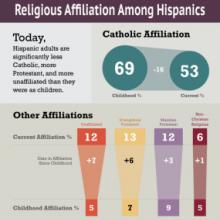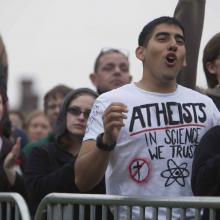agnostic
MOST OF OUR gospel readings in May move through sections in John’s gospel commonly referred to as the “farewell discourse.” In this long goodbye, Jesus and his disciples have finished eating their last supper together. Judas has departed to betray his friend. Now it’s time for Jesus’ final words to the remaining 11. Or, at least, it’s time for him to say goodbye from the perspective of who they’ve known him to be thus far. He’s preparing them for who he is becoming, as well as how he’ll continue to be among them — and, by extension, among us. There’s a lot that Jesus wants to accomplish without fully tipping his hand. So, his speech is at times confusing!
Unsurprisingly, a sense of longing permeates the whole address. These friends are saying goodbye to each other while also scrambling for ways to stay together. Jesus is grieving that goodbye, while also anticipating a joyful return to his Abba in heaven. As he speaks, then, Jesus tells of a fluid, swirling kind of love that permeates and connects God, himself, and his followers all to each other. This fluid love is the Holy Spirit that Jesus will “breathe” upon his followers (John 20:22) — the Holy Spirit who lingers among us still.
Our celebrations at Pentecost tend to focus on the wild descent of fiery tongues upon the early Jesus community — as they should. But in this lectionary cycle, the New Testament readings don’t focus on wind, fire, or tongues. Instead, they have us abide in these less dramatic, more subtle, ambiguous, and mysterious moments. This year, Pentecost calls us to abide in and with a love that often doesn’t make sense, but that always must be shared.
Pope Francis leaves on Monday, Oct. 31 for an overnight trip to Sweden, a historically Protestant country that today is one of the most secular in the world.
The visit is to mark the start of observances of next year’s 500th anniversary of the Reformation, which traditionally dates from Oct. 31, 1517, when Martin Luther nailed his 95 Theses to the door of a German cathedral.
Scholars of Dylan — and they are legion, with many offering entire courses on the singer’s record catalog — have long highlighted the religious imagery of his work. From Old Testament references in “All Along the Watchtower” (1967) and “A Hard Rain’s A-Gonna Fall” (1976) to the New Testament basis of “Gotta Serve Somebody” (1979) and the spiritual yearning of “Thunder on the Mountain” (2006), Dylan’s lyrics and music have long reflected his own restless, seeking soul.
One phrase comes to mind, time and again, when I think of Frank Schaeffer: “THINK AGAIN.” Any time I think I have a handle on things theological, he seems to find the thread, hanging from the edges, and gives it a good, solid yank.
Such is the case once again with his newest book, Why I am an Atheist Who Believes in God: How to give love, create beauty and find peace. Just when it seems the delineations between theism and atheism, between believers and nonbelievers, is sufficiently clear, Schaeffer blurs even those lines, leaving us to wonder what it is any of us actually believes and why.
Frank Schaeffer is not one to deconstruct theology (or even the lack thereof) with some kind of sadistic joy, leaving us to sort through the pieces. Rather he explores what I might call trans-theism, offering us practices, a vocabulary, and a worldview that take us far beyond belief toward a deeply human – and yet inexplicably transcendent – experience.
I asked Frank several questions about his new project; here is what he had to say.
The number of Hispanic-Americans who say they adhere to no religion is growing and now rivals the number of Hispanic evangelicals, a new study has found.
The share of Hispanics living in the U.S. who say they are atheist, agnostic, or have no religious affiliation has reached 12 percent, according to the 2013 Hispanic Values Survey conducted by the Public Religion Research Institute. That is double the rate reported in 1990 by the American Religious Identification Survey.
Researchers say Hispanic “nones” are now statistically equal to the number of U.S. Hispanic evangelical Protestants — 13 percent — and warn of a religious divide in the Hispanic community that will be felt for decades to come.
The American workplace, like the rest of U.S. society, is becoming more religiously diverse and that is raising concerns about employer accommodations for believers — and increasing the odds for uncomfortable moments around the water cooler.
Yet one potential flashpoint among workers does not involve new immigrant faiths but rather two indigenous communities: white evangelicals and unaffiliated Americans who constitute one of the fastest-growing segments of the population.
A major factor contributing to workplace conflict, according to a survey released on Friday, is that evangelicals — whose religious identity is tied to sharing their beliefs — are much more likely to talk about their faith at work than other religious and nonreligious groups.
[The "nones"] recite history and Christian leadership's collusion with the agents of empire-building and warfare. Then they say something like, “I'd rather live like Jesus than be a Christian.”
They see the Church as the rich young man and they wonder if anyone actually follows Jesus anymore.
Of course, this is not the only demographic shift at work in the religious life of the world.
There are more Anglicans in Nigeria than there are in England.
More Presbyterians in Ghana than in Scotland. ..
More Baptists in Southeast Asia than in the Southeastern United States.
More Christians go to church in China than in Europe.
In 1900, 71 percent of the world's Christians were in Western Europe. By 2000 that percentage dropped below twenty percent in some European nations.
Here's the real kicker: these are not problems to fix. They are simply realities to be faced.
 Meet John Q. Nones, a young, white male who is making a big impression on the American religious landscape for something he doesn't do: align with any religious group.
Meet John Q. Nones, a young, white male who is making a big impression on the American religious landscape for something he doesn't do: align with any religious group.
The rise of the religiously unaffiliated, or “nones,” as documented in a new study from the Pew Forum on Religion & Public Life, has major implications for almost all aspects of American life -- from religion to business to culture.
Whether you believe the proliferation of Mr. Nones is a depressing or hopeful trend, it pays to get to know him.
Who is John Q. Nones? Here's a snapshot drawn from the Pew Forum’s new poll.
Keli Goff asks is America would be better off with an agnostic President:
I"t's always refreshing when religious leaders strive to embody the very best values their faith has to offer. I have been reminded of this often over the past year, which is shaping up to be banner one for Christian leaders in the "practice what you preach" department."
Read her full article here
Editor’s Note: At 3:30 p.m. on Saturday, March 27, 2004, when I was the religion reporter for the Chicago Sun-Times, I met then-State Sen. Barack Obama at Café Baci, a small coffee shop at 330 S. Michigan Avenue in Chicago, for an interview about his faith. Our conversation took place a few days after he’d clinched the Democratic nomination for the U.S. Senate seat that he eventually won, and four months before he’d be formally introduced to the rest of the nation during his famous keynote speech at the 2004 Democratic National Conventio.
We spoke for more than an hour. He came alone. He answered everything I asked without notes or hesitation. The profile of Obama that grew from the interview at Cafe Baci became the first in a series in the Sun-Times called “The God Factor,” which would eventually became my first book, The God Factor: Inside the Spiritual Lives of Public People, in which Obama and 31 other high-profile “culture shapers” — including Bono of U2, Nobel Laureate Elie Wiesel, the author Anne Rice and President George W. Bush's speechwriter Michael Gerson — are profiled.
Because of the seemingly evergreen interest in President Obama’s faith and spiritual predilections, and because that 2004 interview remains the longest and most in-depth he’s granted publicly about his faith, I thought it might be helpful to share the transcript of our conversation — uncut and in its entirety — here on God’s Politics.
~ Cathleen Falsani








